Wet conditions and volunteer wheat plants that formed a green bridge over summer combined to push stripe rust disease levels to new highs earlier in the season in eastern Australia.
Growers who applied preventive fungicides at optimal growth stages have generally kept the leaves of susceptible varieties free of disease, protecting crops against potential grain yield losses.
However, those who could not traffic paddocks because of wet conditions or because they waited until symptoms appeared have reported disease hotspots in their crops.
Six agronomists from across Australia report their disease observations from the paddocks of their clients.
Grain Orana Alliance chief executive officer Maurie Street also outlines what he has seen at a network of sentinel wheat variety sites in central New South Wales.
Paul Castor, Queensland
 Independent agronomist Paul Castor is based in Toowoomba, Queensland. He services growers on the Darling Downs and Western Downs. He is a director of MCA Agronomy, which has offices in Chinchilla and Goondiwindi, Queensland
Independent agronomist Paul Castor is based in Toowoomba, Queensland. He services growers on the Darling Downs and Western Downs. He is a director of MCA Agronomy, which has offices in Chinchilla and Goondiwindi, Queensland
Conditions since my last report have favoured stripe rust development.
Season 2022 is probably the worst stripe rust season in memory for growers and agronomists in southern Queensland and north-western NSW.
There has been a definite step up in the level of infection experienced compared with 2021.
Generally, growers are managing stripe rust effectively.
Variety selection, well-timed foliar fungicides and adult plant resistance work well to beat stripe rust, particularly in the earlier-planted crops.
However, there are some cases where significant leaf area loss from stripe rust has occurred.
This is mostly a result of poorly timed or delayed fungicide applications, particularly to varieties with an MR-MS (moderately resistant to moderately susceptible) rating or worse. In addition, MR and R-MR varieties are being unusually challenged. This has been attributed to:
- delayed planting;
- high inoculum levels, particularly when near poorly managed MR-MS or worse varieties; and
- delayed activation of adult plant resistance genes. This has been noted particularly in high-nitrogen situations.
MR or R-MR varieties affected include Sunflex, LRPB Reliant, LRPB Hellfire, LRPB Mustang, late-planted LRPB Lancer and LRPB Raider . Sunflex appears to be reacting very poorly to infection.
Yellow leaf spot is not yet at epidemic levels. Despite receiving plenty of rain this season, the actual number of wet days to date has been significantly less than in previous yellow leaf spot epidemic years.
However, several early sown paddocks were planted into wheat stubble, where the disease is progressing and is prompting the need for fungicide management.
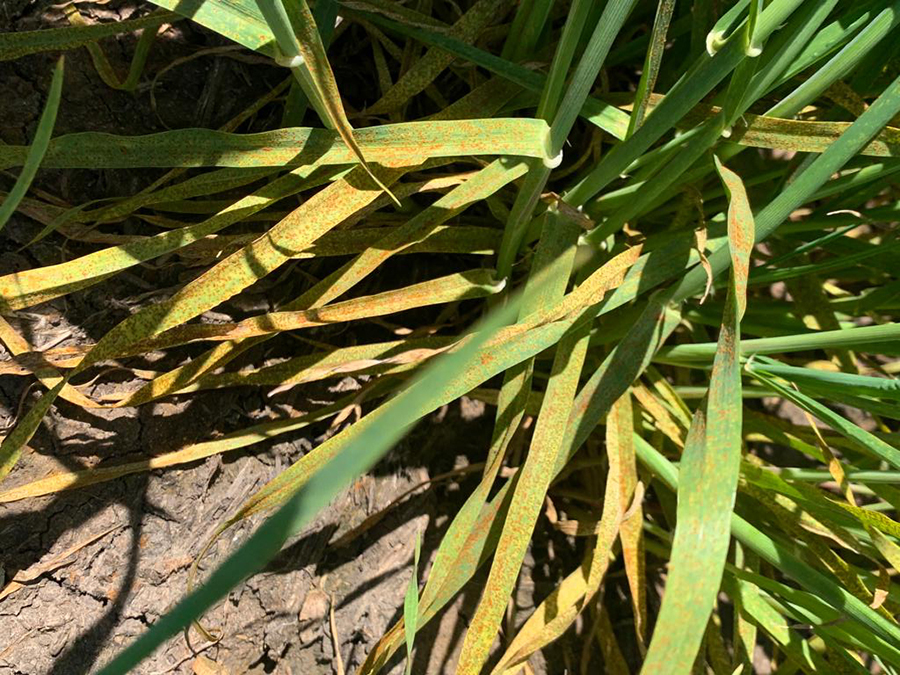
Barley leaf rust in a section of Leabrook barley where fungicide was not applied. Photo: MCA Agronomy
Wheat leaf rust has continued to cycle throughout the winter months at a very slow rate in early planted Sunmax crops. To date, we have not yet noted infections on later-planted MS-S varieties but will continue to monitor these as temperatures warm over the coming weeks.
Wheat powdery mildew is found at low levels in several susceptible varieties, including Sunmax and Sunchaser. Infections do not appear to be progressing as strongly as they are with barley powdery mildew.
Very heavy infections of barley powdery mildew are occurring on the Darling Downs in late-planted susceptible varieties such as Spartacus CL . Fungicides either applied as seed dressings or as foliar treatments are working well in managing this disease.
Barley leaf rust is easily found in many varieties, including Leabrook, Maximus CL and Yeti.
As expected, leaf rust is more difficult to manage with net blotch foliar fungicide programs. This is because it generally comes in later in the season after head emergence as temperatures rise.
As a result, crops are often not protected by earlier net blotch fungicide application timings.
With warming temperatures over the coming weeks, any late-planted susceptible barley crops may come under significant pressure from leaf rust.
Rob Holmes, northern NSW

HMAg’s Rob Holmes, from Moree, NSW, advises clients who run irrigated and dryland farming systems incorporating winter and summer cropping.
In northern NSW around Moree, we continue to find stripe rust in wheat, especially in varieties such as Coolah, Coota and Sunblade CL Plus.
We have also seen the spot form of net blotch in barley and plenty of crown rot in some wheat and barley crops.
Rust is also increasing in faba beans.
Most growers have managed these diseases by using preventive foliar fungicides based on the crop’s susceptibility to the disease.
Other growers are applying fungicides in response to the severity of the diseases they are seeing in their crops.
Stripe rust is more prevalent this season than it was last season and is likely to be around in 2023 if we maintain a green bridge of suitable hosts over the summer period.
Rust in faba beans is also more prevalent and severe than it was last season.
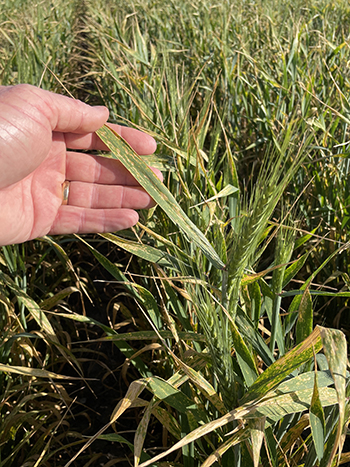
Coolah wheat shows signs of stripe rust on the flag leaf. Photo: Rob Holmes
This is because the green bridge over summer caused by frequent rainfall events allowed the pathogens to survive and infect this year’s crops.
Generally, growers who are applying preventive fungicide applications are seeing effective control of most diseases.
However, on some paddocks with disease-susceptible varieties, the applied fungicides struggle to suppress diseases.
We have also seen some varieties express symptoms greater than expected.
On susceptible wheat crops, growers have had to apply more than one fungicide application to gain effective protection against diseases.
However, most Moree growers have planted wheat varieties that are reasonably resistant to stripe rust.
Accordingly, most of these varieties have only needed one preventive fungicide spray.
Maurie Street, central NSW

Grain Orana Alliance chief executive officer Maurie Street runs stripe rust screens at Coonamble, Tottenham, Coolah, Gilgandra and Wongarbon in central NSW. These plot-sized plantings of 18 wheat varieties are an early warning system for stripe rust. The pilot study has GRDC investment.
In the 18 wheat varieties sown across five central NSW locations earlier this year, we saw significant and early onset of stripe rust. The infection levels were higher and earlier than in past seasons.
The early onset of stripe rust was not surprising because of back-to-back favourable seasons with wet summer–autumn conditions. These factors led to plenty of volunteer wheat left on paddocks that formed a green bridge, hosting stripe rust over summer. This allowed inoculum to build up in the system before sowing in 2022.
With an epidemic already established, early sown crops were subjected to significant disease pressure by early tillering.
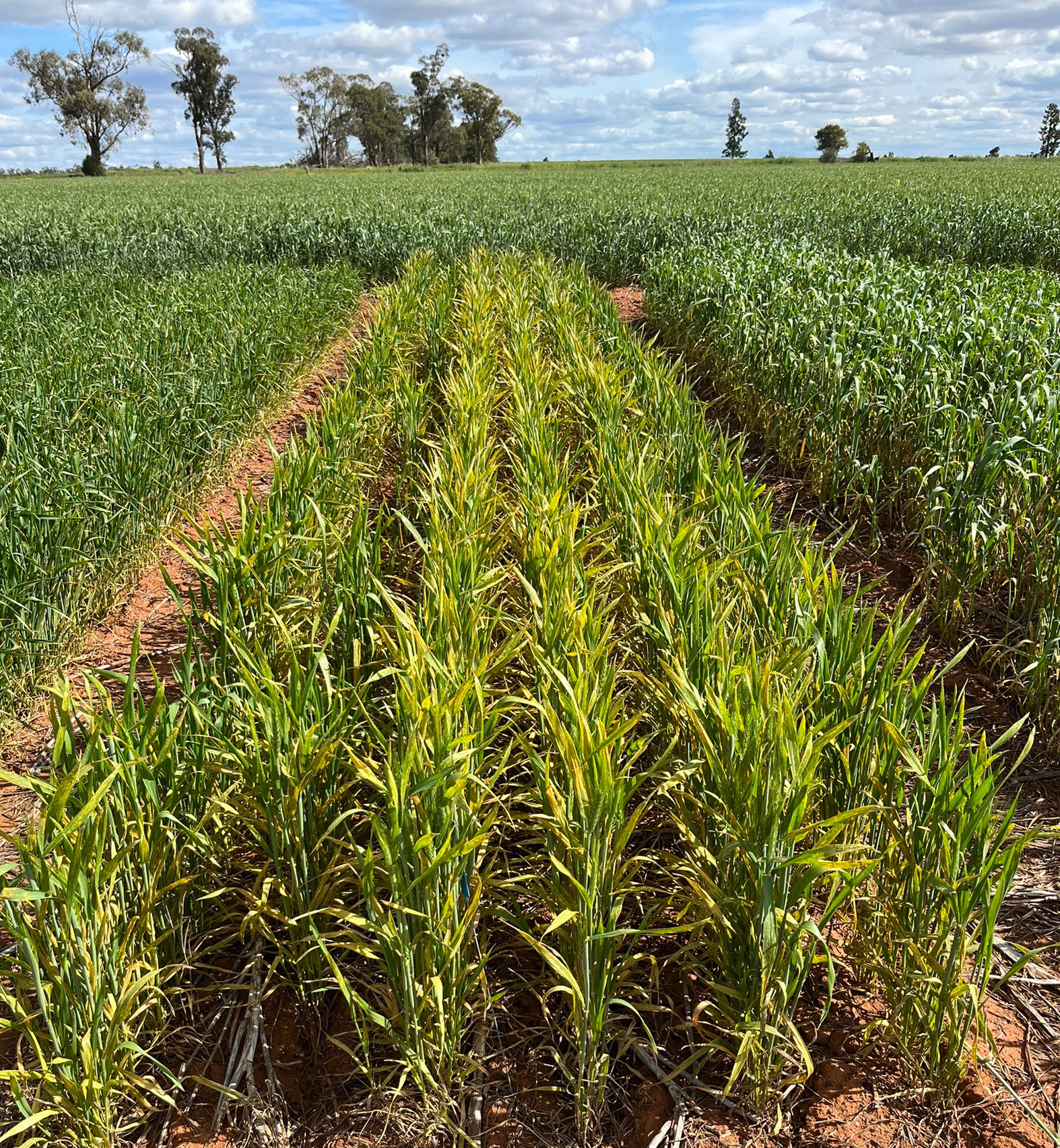
Vixen is displaying high levels of stripe rust this season. Photo: Maurie Street
Genetic resistance in wheat is largely based on what is referred to as adult plant resistance (APR). As the name suggests, these sometimes do not ‘kick in’ until later in the crop’s development.
The timing of APR expression varies between varieties concerning their level of resistance. However, stripe rust can infect most wheat varieties, even the more-resistant types, at the seedling stage.
The presence of stripe rust in young wheat crops with higher levels of resistance does not mean that their APR is no longer effective. It is not a sign that a new pathotype has emerged.
The significant level of stripe rust in seedling wheat crops was more of an indication of just how early the epidemic was in 2022.
As the plant continues to develop and push into later growth stages, the APR will become active and clean out existing leaf infections and prevent new ones.
Within the trials, several varieties have taken stripe rust infections worse than in 2021. This could be related to several factors, such as:
- the wider distribution of the 239 pathotype in 2022;
- spread of the 238 pathotype (variation of 198 pathotype that gives same virulence as 239 pathotype), which had limited detections last season; and
- significantly earlier and higher stripe rust pressure this year.
We have collected tissue samples from the sentinel sites and sent them to the University of Sydney for pathotyping.
It is worth noting that R to MR-rated varieties are not completely immune to showing some level of infection under extreme disease pressure.
While varieties with an MR rating will take on some stripe rust, when you compare it to an S or VS variety you can see that the genetic mechanisms in the MR variety are doing an effective job given the extreme stripe rust pressure crops are under this season.
For example, we saw stripe rust in varieties such as LRPB Hellfire, Beckom and LRPB Lancer earlier in their development. However, when now compared with Vixen, Scepter and Devil, these R to MR varieties are displaying significantly enhanced levels of resistance to this disease.
However, if high levels of stripe rust are found in an MR variety, double-check your records to ensure the variety is what was planted. Also check that the seed lot was not contaminated with a more susceptible variety. Seed contamination is evident as individual scattered plants across a paddock having significant stripe rust while the main plant type is relatively clean.
Crop yellowing may not be stripe rust. It could be yellow leaf spot, leaf tipping driven by varietal genetics, waterlogging or nitrogen deficiency.

While Beckom displayed stripe rust symptoms at the seedling growth stage, it is now showing effective APR to the disease at central NSW trial sites. Yellowing, leaf loss and leaf lesions in this case are largely driven by yellow leaf spot, where stubble cover was left on paddocks. Photo: Maurie Street
Remember that it is too late if a crop has turned yellow. Although fungicides have some curative effects, they are best applied at the appropriate growth stages to prevent stripe rust infection. Always read the label.
Fungicides are effective in preventing or managing stripe rust infections, but they do not come without costs. These include the cost of buying the fungicide and treating the crop but also potentially in the development of fungicide resistance in either stripe rust or powdery mildew. For example, some triazole fungicide actives no longer work as effectively to protect some populations from powdery mildew.
For MS or lower-rated varieties, applying the fungicide flutriafol to fertiliser would be worthwhile. It would also be worth applying a Z32 spray and monitoring the crop from there forward.
But if you are growing an R to MR variety, the case for applying fungicide to fertiliser might not be justified. Remember that wheat plants generally put on more leaves than they need to support grain yield.
Accordingly, they can afford to lose some green leaf area without affecting grain yield. Spraying these varieties to achieve a completely blemish-free crop may not be warranted even in a high-yield-potential year.
Recently, people have been worried about LRPB Lancer, but at our sentinel sites, the variety is showing effective resistance to stripe rust.
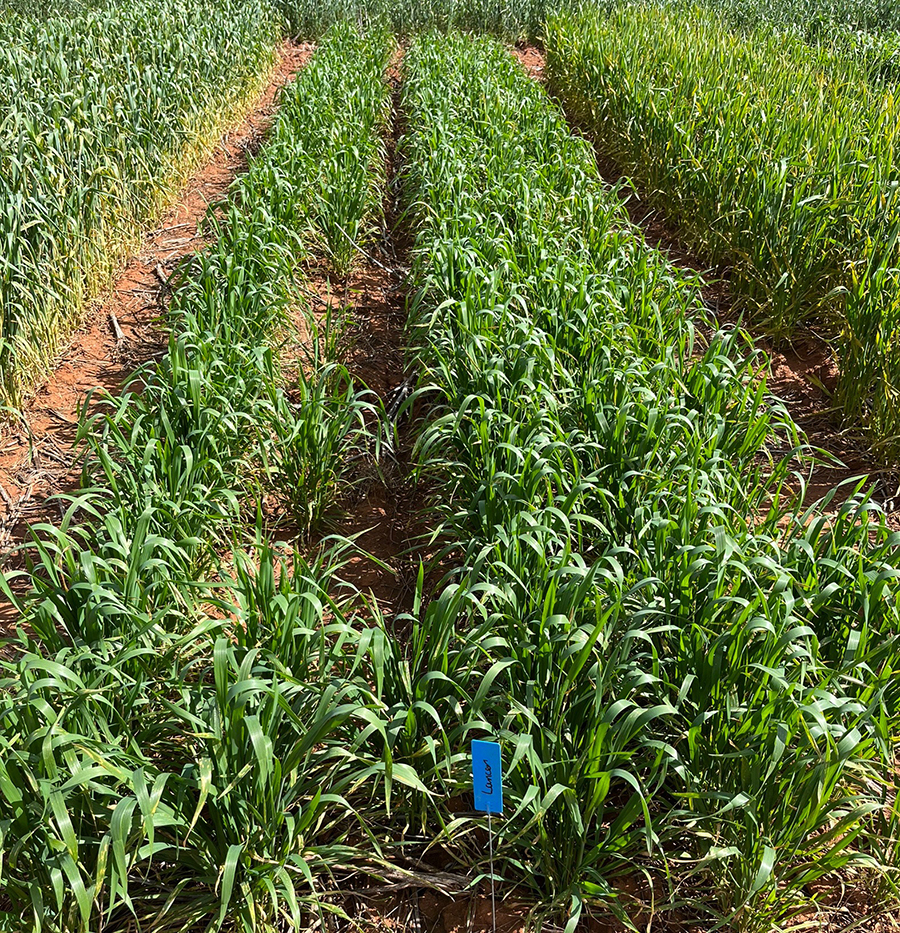
LRPB Lancer shows adequate resistance to stripe rust in central NSW. Photo: Maurie Street
Generally, Vixen (PBR), Emu Rock (PBR), and LRPB Trojan (PBR) are badly affected by stripe rust. Scepter (PBR) is taking on stripe rust, but it is not the worst affected.
Borlaug 100 was affected by stripe rust early in its development but now appears to be holding up better. This indicates that the 239 stripe rust pathotype may be dominant at some of these sites.
Nonetheless, we have seen elevated levels of stripe rust in Coolah and LRPB Flanker , which traditionally had reasonably sound resistance packages before the introduction and spread of the exotic 239 pathotype.
LRPB Spitfire and LRPB Hellfire are showing moderate infection but are holding up well.
The cleanest plots are Longsword and LRPB Lancer . Beckom is relatively free of stripe rust but has yellowing on its leaf tips, which is unrelated to stripe rust.
Growers should also be very cautious about applying fungicides to crops beyond the flowering stage as they seriously risk withholding periods from harvest and breaching maximum residue limits (MRLs) in harvested grain.
Emma Robinson, southern NSW

At Temora, in the south-west slopes region of NSW, Nutrien Ag Solutions agronomist Emma Robinson provides advice to mixed farmers growing winter crops.
In the Temora, NSW, district, like most other areas across NSW, we continue to see stripe rust and Septoria in wheat.
Recently, though, we are also seeing new wheat powdery mildew infections in crops from early tillering to the flag leaf growth stage, which is not something we see much of, apart from in the headlands in susceptible varieties.
This brings with it a new dimension to disease management decisions due to suspected reduced sensitivity to triazoles and resistance to strobilurins.
At the moment, it feels like the calm before the storm. With warmer weather coming and conditions predicted to continue to be wet as well as humid, diseases in cereal and broadleaf crops will really be in their element.
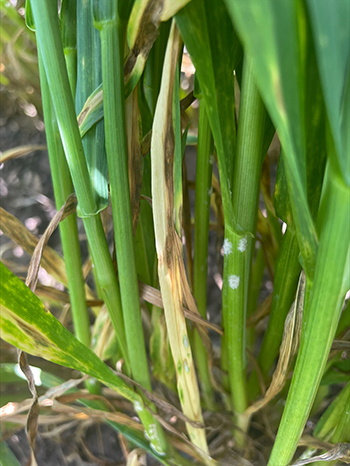
Powdery mildew infections in wheat. Photo: Emma Robinson
Although we have a lid on most crop diseases, some growers have had disease blowouts because they could not apply the fungicide as planned at specific growth stages due to wet conditions.
The Temora district is witnessing more disease pressure than we have ever seen before. We have everything.
Constant wet weather, overcast days, humidity, low variety disease resistance and the summer green bridge have combined to encourage every cereal disease to proliferate.
We are also seeing scald and net blotch in barley.
Unfortunately, many areas around Temora have been too wet to apply fungicides at the optimal or planned timings because of the inability to hire planes or accommodate aircraft on decent airstrips.
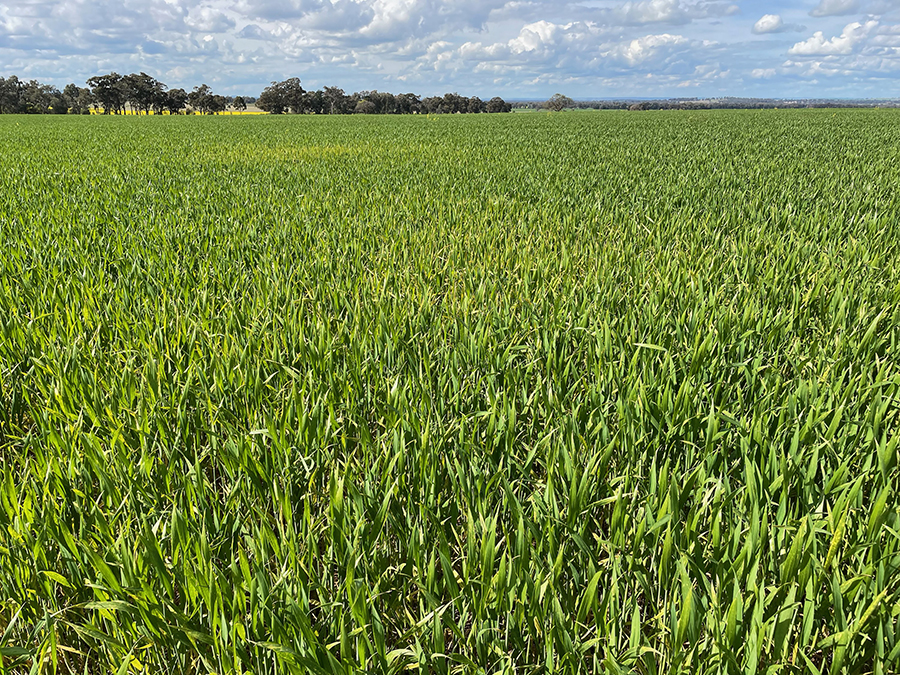
Stripe rust hotspots in Catapult wheat at ear emergence. Hot spots developed after the paddock was sprayed two weeks earlier by air with epoxiconazole. The entire farm was planned to be sprayed earlier, but conditions were too wet. The grower had to wait three weeks for a plane to do the job. The crop was sprayed again during the second week of September with Amistar® Xtra.
We observed seedling stripe rust in most wheat varieties early, but this has not caused hot spots or moved into the upper canopy in most situations until close to flag leaf emergence.
Most wheat and barley crops were planted with flutriafol (Impact®) treated fertiliser at sowing. This helped to prevent diseases such as stripe rust in varieties with poor adult plant resistance.
Varieties such as Catapult, Coota and Vixen are taking on heavy levels of stripe rust north of Temora, where growers have not been able to traffic paddocks to spray at the Zadok’s growth stage 32.
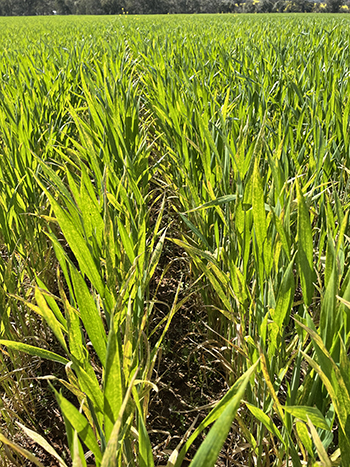
Stripe rust in Catapult wheat at ear emergence. Photo: Emma Robinson
All disease was planned to be dealt with using the two preventive timings at Z32 using epoxiconazole or prothioconazole plus tebuconazole (Prosaro® 420), and then a Z39 (full flag leaf) spray using a ‘top shelf’ fungicide such as azoxystrobin and cyproconazole (Amistar® Xtra). However, this approach had to change because of the extended wet conditions. The levels and length of disease control also changed because growers applied fungicide after seeing infection symptoms.
North of Temora, there are distinct areas of extremely wet country where foliar diseases have not been managed as intended at planting. Growers with cereals in these areas are now going into damage control, attempting to keep the flag leaf clean.
These growers used a higher rate of epoxiconazole, closely followed by a late flag leaf or head wash application using either strobilurin products or Prosaro®.
Such products were applied mostly by aircraft. Unfortunately, we observed rust hotspots form in these paddocks after application. We also saw Septoria and powdery mildew running up the canopy at the flag-3 growth stage.
Although we saw the same situation play out last year, the difference this year was that we saw far more stripe rust and Septoria earlier in the season. We still have a long way to go to keep crops clean, with conditions being considerably wetter this September than last year – which is optimal for disease development.
Growers are seeing effective control where products of choice were applied at the correct timing. But where products were applied later, in many situations, crops have been infected already, and we are chasing our tails to keep the flag and head clean. Delayed fungicide application allows continued disease progression within the canopy resulting in more infections at the time of application, where fungicides have weaker curative activity than protectant activity.
Growers have applied one to two more fungicides than they applied last year because of the appearance of both Septoria and powdery mildew in varieties such as Beckom and LRPB Lancer. Generally, in an average year, these wheat varieties do not require any stripe rust or Septoria management.
John Stuchbery, Victoria
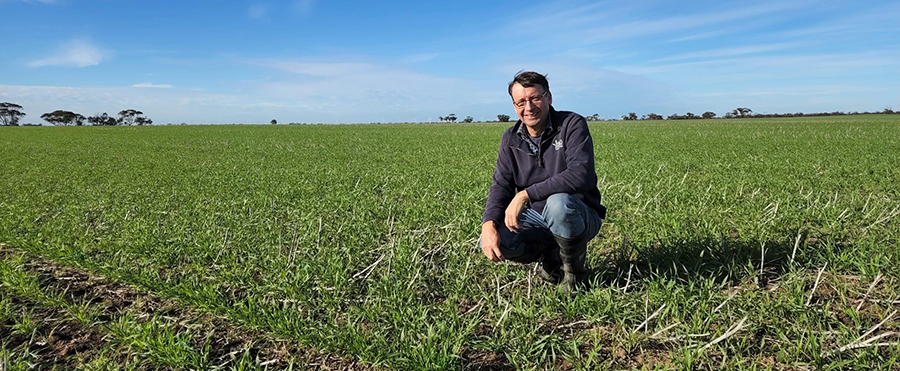
John Stuchbery is an independent agronomist based at Donald, Victoria. He advises growers cultivating winter crops in the Wimmera’s medium-rainfall zone.
There has been plenty of stripe rust in wheat crops in the Victorian Wimmera and Mallee.
Most of our clients planted Scepter, but stripe rust has also been found in other varieties such as Hammer CL Plus, Vixen and Sheriff CL Plus.
Compared with last year, we have seen more stripe rust this year. The disease developed earlier, giving the pathogen more time to build, putting a higher level of disease pressure on crops.
Last year there was a dry spell in August and September that slowed down foliar disease cycling in most crops, but this year it has been continuously wet.
There has been plenty of Septoria tritici blotch in Scepter wheat during winter. However, the disease has just started to spread up the canopy during the past three to four weeks. We have also seen some powdery mildew in the Mallee.
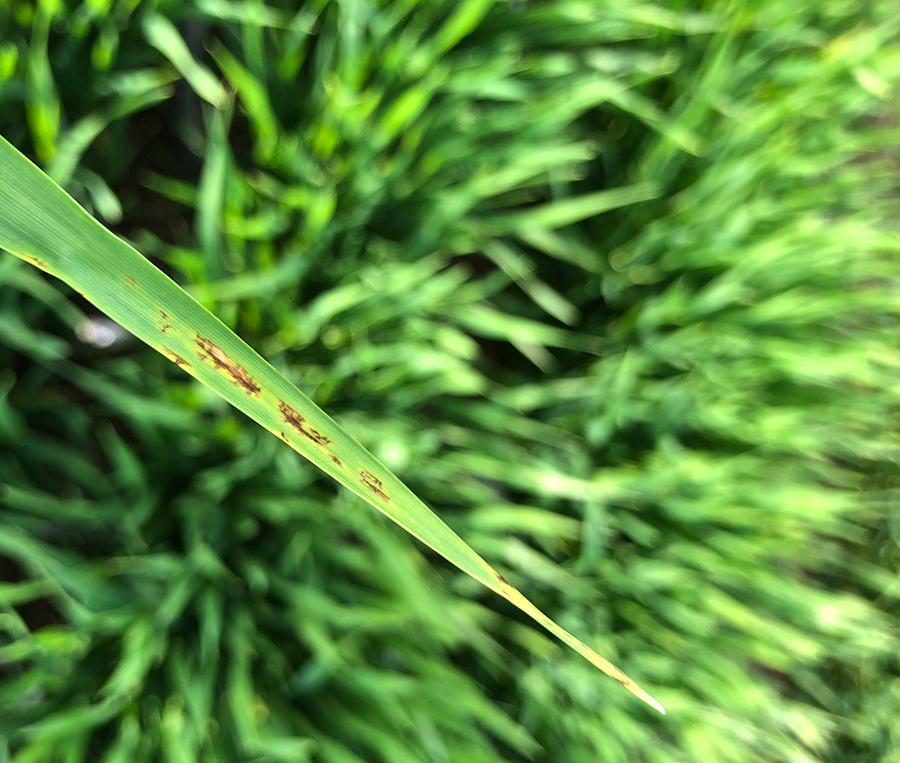
Net form net blotch in Spartacus CL barley. Photo: John Stuchbery
In barley, we have seen spot form and net form of net blotch. We have also seen some barley leaf scald. While this has not yet taken off, we are expecting it will become more prominent with the wet weather conditions that have been forecast.
Many people switched from Spartacus CL barley to Maximus CL barley this year, which has better resistance to net blotches. Our paddock inspections have shown that Maximus CL crops have much less spot form and net form of net blotch than Spartacus CL or RGT Planet.
We have also seen early signs of leaf rust in Commodus (PBR) CL barley, which is rated as SVS (susceptible to very susceptible). Leaf rust can develop rapidly in wet conditions as average temperatures increase in spring.
Seasonal conditions have allowed foliar diseases to proliferate this year. But growers who applied fungicides proactively at the correct growth stages have kept these diseases under control.
It is yet to be seen if there will be a need for another fungicide application. Nonetheless, it will be important to be open to doing that. With good crops and good prices, there is a fair bit at stake.
Jeff Braun, South Australia

Independent agronomist Jeff Braun with son Zac. Jeff advises growers on South Australia’s Yorke Peninsula, the mid-north and Mallee.
We are seeing stripe rust in most areas where crops were planted early in South Australia, which we hardly saw at all last year.
The main wheat varieties affected have been DS Bennett , Sheriff CL Plus, Vixen and RockStar, where stripe rust could be readily found if they were not covered by an early fungicide or in-furrow fungicide treatment.
Where growers did not apply an early stem elongation fungicide, many have found stripe rust hot spots when treating their wheat with a flag leaf fungicide.
We have also found plenty of powdery mildew in SA’s Mallee and the coastal upper Yorke Peninsula.
With fungicide treatment in combination with the potential rising temperatures coming into spring, it is hoped the disease will become less of an issue.
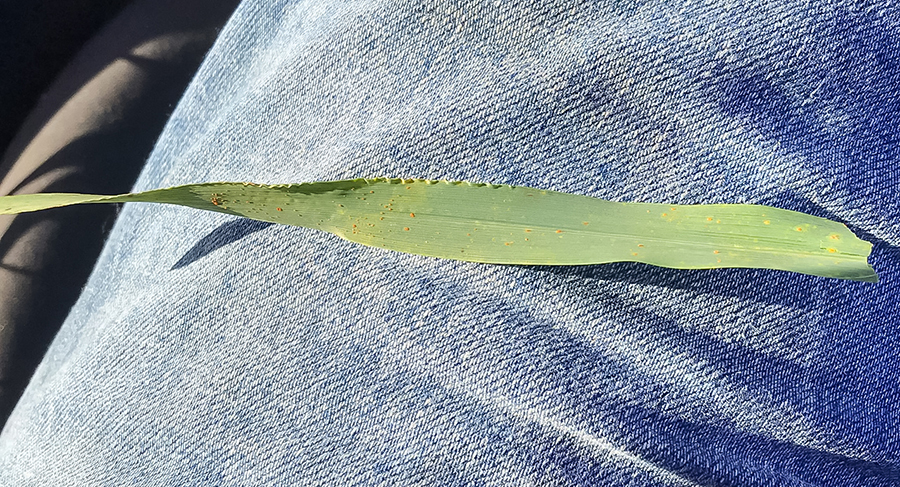
Leaf rust in Compass barley. Photo: Jeff Braun
On barley, where a growth stage 37 to 39 fungicide was not applied, we have seen some leaf rust and scald. Overall, growers have managed diseases well by applying preventive fungicide sprays.
The aggressiveness of stripe rust on susceptible wheat varieties when fungicide management timing is not spot-on is making us rethink the varieties we are growing.
Trent Butcher, Western Australia

ConsultAg research agronomist Trent Butcher is based in Narrogin, Western Australia. He advises mixed farmers and continuous croppers from the west of Narrogin to Lake King in WA’s eastern grain belt.
We have not seen stripe rust in Western Australia. There have been recent reports of wheat leaf rust in the Geraldton port zone in Vixen wheat.
There has been a significant amount of powdery mildew in Scepter wheat. We have had mild and wet conditions for the past three to four weeks without a warm weather change. Accordingly, powdery mildew is persisting, or just beginning to appear in some crops further south.
Powdery mildew has not been a significant issue in this area for the past few years. The weather outlook has prompted many to act with fungicides, while others with low disease levels closely monitor crops and the weather going forward.
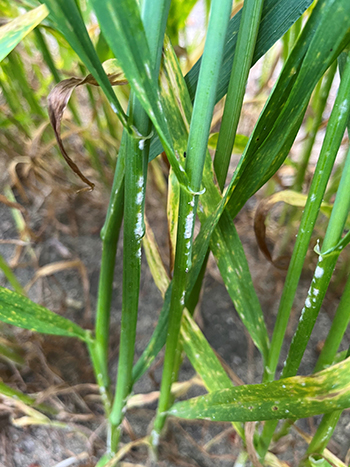
Powdery mildew in Scepter wheat. Photo: Trent Butcher
During the second week of September, most wheat crops were at flag leaf and were recently sprayed with a fungicide to treat yellow spot and Septoria, which in many cases also treated the powdery mildew.
Spot form of net blotch has continued to persist in barley all year, at a similar level to last year. We have seen fewer symptoms of net form of net blotch compared with what we saw last year, particularly in RGT Planet.
The final sprays for net blotch were applied during the second week of September as most crops were too wet previously.
Oat growers applied a flag leaf spray for Septoria avenae leaf blotch, which has been more prominent than last year.
We saw the odd case of leaf rust (crown rust), particularly in Wandering oats. It has appeared a few weeks earlier than we would normally expect, but it is not yet at a level that requires spraying.
Overall, growers appear to be achieving effective levels of control. The approach has been shifting to using higher-quality fungicides and the right tool for the job, rather than cheaper alternatives, which is helping considerably.

























































